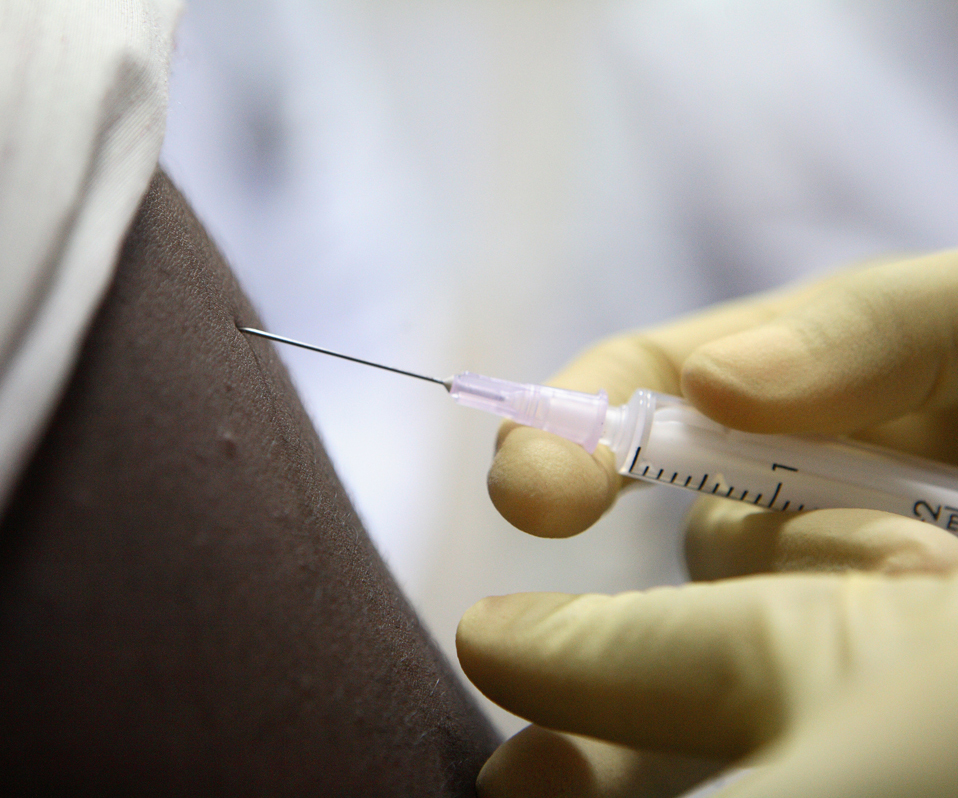October 29, 2020
IAVI Announces Start of Clinical Trial of Next-Generation HIV Vaccine Candidate
Aim is production of precursors to broadly neutralizing antibodies.
NEW YORK — OCTOBER 29, 2020 — IAVI, a nonprofit scientific research organization dedicated to addressing urgent, unmet global health challenges, announced today that the first dose of a novel HIV vaccine candidate has been administered to a volunteer participating in a Phase I clinical trial. The dose was given at Amsterdam University Medical Centres. Two other trial sites, at Rockefeller University in New York City and George Washington University in Washington, D.C, will screen volunteers and administer vaccinations in the coming weeks.
 Vaccination being given in clinical trial. Photo credit: Jean-Marc Giboux/IAVI
Vaccination being given in clinical trial. Photo credit: Jean-Marc Giboux/IAVI
The goal of the trial, known as IAVI C101 (also GSK-PRO-HIV-016), is to evaluate the safety, tolerability, and immunogenicity of the vaccine candidate BG505 SOSIP.GT.1.1 gp140.
Mark Feinberg, M.D., Ph.D., president and CEO of IAVI, said, “HIV/AIDS remains a persistent, urgent health risk across the world, and only a vaccine has the potential to help us eliminate HIV as a global public health threat. We and our partners are excited by the advances made to design and characterize this innovative vaccine candidate, and we are now poised to evaluate its potential to serve as a first critical step in developing the immune system’s response to help block HIV infection. Additionally, we’re happy to have expanded our partnership with Amsterdam University Medical Centres to include the conduct of clinical trials, following our longstanding collaboration with Rogier Sanders and colleagues on HIV vaccine candidate design.”
BG505 SOSIP.GT.1.1 gp140 is a new version of a construct used in another HIV vaccine candidate that entered clinical trials in 2019. That immunogen, BG505 SOSIP.664 gp140, was engineered by a team directed by John P. Moore, Ph.D., at the Weill Cornell Medical College; Rogier Sanders, Ph.D., at Amsterdam University Medical Centres; and Andrew B. Ward, Ph.D., and Ian A. Wilson, D.Phil., at Scripps Research. The outcome of their work was an important advance in stabilizing the highly fragile HIV surface glycoprotein, Env, in its native-like configuration. Env, shaped like a three-pronged spike called a trimer, is a target for antibodies produced by the human immune system after infection. Some of these antibodies are able to block viral entry into cells.
Sanders and his team reengineered the BG505 SOSIP.664 trimer with the aim of engaging cells of the immune system that produce two specific classes of antibodies that are able to attach to certain locations on the surface of HIV. In mouse studies, BG505 SOSIP.GT.1.1 gp140 activated immune cells that produced the desired antibodies and led to antibody binding responses.1 While vaccination with BG505 SOSIP.GT.1.1 gp140 on its own is not expected to lead to production of antibodies that can broadly bind to and neutralize a range of genetically variable HIV strains, the hope is that vaccination with a carefully designed sequence of immunogens will guide immune cells eventually to produce such broadly neutralizing antibodies (bnAbs).
Sanders said, “I am very excited to see how well this vaccine candidate is able to mobilize B cells in specific ways. Depending on the results, we think that this trimer has the potential to be part of a vaccine regimen that elicits broadly neutralizing antibodies. Understanding how people respond to this vaccine candidate will give us crucial information about next steps for this approach. We all share the goal of a globally effective HIV vaccine, and trials like this will help us get closer to that aim.”
The principal investigator at the Amsterdam trial site, Godelieve de Bree, M.D., Ph.D., infectious diseases specialist, Amsterdam University Medical Centres, said, “Through great and inspiring collaboration between several departments at Amsterdam University Medical Centres, we built the infrastructure for Phase I HIV vaccination trials. I am delighted that we can contribute to safe clinical testing of the vaccine candidate and in-depth research of its potential.”
The trial will enroll 48 adults, ages 18-50, who are HIV negative. Each participant will receive three doses of BG505 SOSIP.GT.1.1 gp140 formulated with an adjuvant developed by GSK, or placebo. Adjuvants are substances used to enhance immune responses induced by a vaccine. The vaccine candidate is administered through intramuscular injection at 0, 2, and 6 months.
Teams at the trial locations will monitor participants for safety for 12 months after the administration of the last dose. Partners across the Collaboration for AIDS Vaccine Discovery (CAVD) will evaluate the comprehensive vaccine-elicited immune response in each participant. Results of the IAVI C101 trial are expected at the end of 2022.
In addition to de Bree, the trial’s other principal investigators are Marina Caskey, M.D., associate professor of clinical investigation, Rockefeller University; and David Diemert, M.D., professor of medicine, George Washington University School of Medicine and Health Sciences.
Contract manufacturing organization KBI Biopharma is manufacturing the vaccine candidate used in the trial. Other key partners are the CAVD Comprehensive Cellular Vaccine Immune Monitoring Consortium (CCVIMC), the Dale and Betty Bumpers Vaccine Research Center (VRC) at the National Institute of Allergy and Infectious Diseases (NIAID)/National Institutes of Health (NIH), Duke University Comprehensive Antibody Vaccine Immune Monitoring Consortium (CAVIMC), GSK, Scripps Research, and Weill Cornell Medical College. The CAVD Vaccine Immunology Statistical Center (VISC) will conduct the immunology analysis, and The Emmes Company LLC will conduct the safety analysis.
The IAVI C101 trial is supported by the Bill & Melinda Gates Foundation.
1 Medina-Ramírez M, et al. Design and crystal structure of a native-like HIV-1 envelope trimer that engages multiple broadly neutralizing antibody precursors in vivo. Journal of Experimental Medicine. 2017 Sep 4;214(9):2573-90.